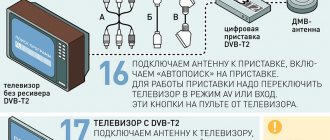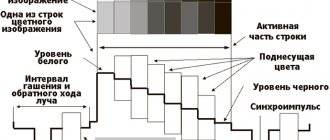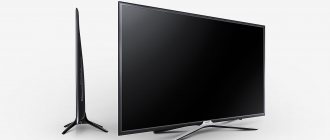Do you know how modern cable television differs from the old, analog, “from the 90s”? Is it really possible to transmit hundreds of channels via cable? How does the signal get to your apartment? “City News” and cable TV operator “Interra” answer these and other questions. They also tell you why cable TV in Revda can (and should) be cheap.
Alexey Tikhonov, network installer, cable technician. Works since 2009 in . Photo// Ksenia Kakshina, Revda-info.ru
What exactly is “digital cable television”?
Cable TV became ubiquitous in the 90s. Operators worked on networks built on coaxial copper cable, which ran sequentially from house to house. Accordingly, the signal went in analog mode, from house to house, without encryption. And through the copper endings it got to the subscribers’ TVs. All this had a bad effect on quality, which extremely irritated subscribers.
Modern cable television is built on digital data transmission. Yes, just like any digital TV. The signal is delivered to homes using digital encryption. Each house is equipped with equipment that decrypts the signal and delivers it to subscribers’ apartments.
To put it very simply, digital cable TV is one in which both sound and picture are encrypted in binary code. This allows you to maintain the quality in its original form. It does not change during encryption and decryption.
How to determine the broadcast type
It is impossible to tell by eye, just by the type of wire, whether cable television is digital. The ideal option to obtain accurate information about the type of broadcast is to call the provider . But it happens that the new home owner simply does not know whose services the previous owners of the apartment used.
In this case, you can determine whether the wire is digital or analog using any TV. The cable is inserted into the antenna socket. After this, an automatic channel search is performed. An old analog TV on digital cable will not find anything at all. But the modern model will show everything clearly and in detail. That is, it will display a summary table indicating the number of digital and analog channels.
But you still shouldn’t abandon the idea of calling your provider. Firstly, you will still have to conclude a new agreement. Secondly, it can broadcast in a hybrid scheme, offering a digital stream of channels and requiring an Internet connection to authorize the user and decode the broadcast.
How can I choose the channels I need?
Focusing on the interests of your family, of course. Have children? We need cartoons. Elderly? TV programs about health, series. Men? Sports, fishing, hunting. The right operator has a call center (you've probably received a call at least once asking how often you watch TV and what exactly). Based on the requests of subscribers, they compile a list of channels. With TV series and films, for example, or educational ones. But you, of course, get the entire available list - and decide for yourself what you will watch.
Satellite TV: how much does it cost and who is it suitable for?
Satellite television has a different broadcasting principle. In this case, the signal comes directly from the satellite, bypassing the TV tower, to a special satellite dish (the same “dish”). The “delivery” of the signal from the satellite to the dish is carried out by the satellite TV operator, who charges a fee for its services.
On the one hand, the benefit seems rather dubious:
- Satellite TV requires special equipment . A set for receiving satellite television costs more than 3.5 thousand rubles, although this is a one-time purchase. It includes the “dish” itself, which also requires external installation, and a set-top box that will transmit the antenna signal to the TV.
- Satellite TV is provided at tariffs . When purchasing a dish, you must connect at least one channel package, for which a subscription fee is charged. Therefore, not a single satellite operator has a basic package of only twenty federal channels, otherwise they would not have the right to take money from you.
- Satellite TV requires space to receive the signal . In a densely populated area with developed infrastructure, where high-rise buildings and other buildings, wires, trees, poles, as well as various electromagnetic fields may interfere with the antenna’s signal reception, it may arrive weakly or with interference. For reliable reception there should be nothing between the antenna and the sky.
Satellite TV sets
Cost - from 1200 rubles.
depending on the configuration. Buy
On the other hand, the disadvantages of satellite TV, when looked at in a certain way, turn into advantages:
- Satellite TV broadcasts directly from a satellite . This means that the signal does not depend on how close your house is to the TV tower - you can catch a “satellite” even in the taiga, if only you had an antenna. The coverage of satellite TV is thus greater than that of digital, and much greater than that of cable, which is discussed below. The main thing is that there is no physical interference in the signal path.
- Satellite TV offers cheap rates . In fact, prices from satellite TV operators are quite low, and the conditions are favorable. For a basic package of 20 state and, for example, 160 paid channels, you will be charged about 150 rubles per month - and some operators have special “economical” packages for 50-60 rubles. If desired, you can add additional ones to the basic package.
- Satellite TV allows you to watch foreign channels. After all, TV channels from different countries can broadcast via a common satellite. If, for example, you are a passionate sports fan, and the matches of your favorite team are not broadcast in Russia, an additional package of foreign sports channels will help you. This option is only available from a satellite.
What conclusion can be drawn from this? Satellite TV is an ideal option for those who live far from a TV tower (for example, in a regional village) and for summer residents to whom terrestrial TV “does not reach.” And also for residents of the upper floors of high-rise buildings in cities - they can afford to install a dish and watch more channels for a small fee, and not be content with the “Culture” channel and the “Fashionable Sentence” program. And also for those who don’t like it when the state dictates what to watch.
Summary
The main difference between digital TV and cable TV is that the former can use two types of signals. The second type has many varieties and uses a variety of transmission media, and also provides higher quality compared to cable.
Post Views: 1,180
More from Video surveillance
620
Types and purpose of surveillance cameras
Published 03/22/2021 Vladimir Basmanov 0
CCTV cameras are a convenient tool for increasing the security of your home. They may differ in size, appearance and technical characteristics. To …
204
Video surveillance in an apartment: where to install and what equipment to choose
Published 03/19/2021 Vladimir Basmanov 0
Whether you live in a studio apartment or a six-bedroom apartment, video surveillance systems help protect you. ...
235
How to receive digital TV
Reception of a digital signal is possible if the TV has a built-in receiver that supports the following formats:
- DVB-T2 – for receiving over-the-air signals.
- DVB-C, DVB-C2 – for connecting to cable television.
- DVB-S, DVB-S2 – for reception via satellite dish.
Another way to get a high-quality digital signal is to connect to the Internet. To do this, the TV must have a Wi-Fi or LAN input and support Smart mode.
If the TV meets the listed parameters, the only thing left is the settings. You need to set the signal source - cable, antenna or Wi Fi (LAN). Then switch to searching for digital channels and wait for the result. Otherwise, you will have to purchase the appropriate attachment. Most likely, you can use an old one as an antenna, which picked up an analog signal. In rare exceptions, you have to tune it exactly to the television center or buy a new one. Especially for such cases, we have prepared an article about which antenna to choose for digital TV.
How to connect
To connect cable television, the presence of specialists is required; the subscriber will not be able to cope on his own. Unauthorized tapping into the system entails criminal or administrative liability. Therefore, if you want to enjoy cable broadcasting, the user should contact the provider. Our specialists will independently carry out all connection work quickly and efficiently.
After connecting cable TV, the user has the opportunity to view hundreds of channels, as well as videos, weather forecasts and much more.
For a relatively small subscription fee, the subscriber will receive high-quality broadcasting and pleasant emotions.
Possibilities of modern TV
Modern TVs support Internet access. For digital cable television reception, fiber optic or coaxial cables are used.
Today TV can be divided into several types according to different criteria. According to the broadcast form it is:
- Ground. A popular form of transition from analog. Over-the-air broadcasting is received via a television antenna. This ensures fewer glitches and lower viewing costs.
- Satellite. A widely used option with no geographic restrictions. Reception is via satellites. This usually requires a paid subscription, but there are also free services.
Digital TV is divided into three types of video clarity:
- Standard (SDTV). This is the basic level of display and resolution. The transmission can be in traditional (4:3) or widescreen (16:9) format.
- Enhanced (EDTV). Available in 16:9 or 4:3 formats, it provides a better picture by replacing interlaced scanning with progressive scanning.
- High (HDTV). Broadcast only in widescreen format (16:9) and progressive scan, which provides the highest video clarity and resolution.
Transition from analogue to digital broadcasting
The first country to introduce digital broadcasting was Great Britain. This was done back in 1998. The full transition was made in October 2012. At the same time, Lithuania also switched to digital.
In Russia, the decision to switch was made later. In 2004, the president signed a corresponding order. According to the document, the transition to digital broadcasting was to be completed by 2015. But soon the decision was changed, and the deadline was postponed several years later. This happened for technical reasons: while the country focused on selling televisions that work with the global DVB-T broadcasting standard. Testing has shown that the equipment works in MPEG-4 format. But this is not enough. It also turned out that in Ostankino they cannot convert the signal for an uninterrupted signal according to.
Now all the main federal TV channels have switched to digital, but regional ones are not subject to the transition order and can continue broadcasting in analogue for now.
Initially, they planned to create three multi-complexes so that Russians could choose. But this idea was soon abandoned. What exactly was the reason is not known for certain, but the implementation was also influenced by the financial side: the creation and maintenance of multi-complexes is quite expensive, so at first there will be only one option. Initially, it was planned that 20-24 digital TV channels would become available to residents of the country, but now only nine have been able to switch to this type of broadcasting. For greater motivation, analogue broadcasting began to be switched off in 2021.











